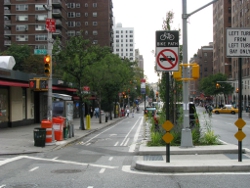New York City Complete Streets Design Guidance
New York City, New York
Source: Pedestrian and Bicycle Information Center (PBIC)
Problem
Many of New York City's streets are overly congested with a number of obstacles that can hinder ease and comfort of mobility by pedestrians and affect access to transit. Safety for bicyclists on the road and pedestrians crossing the street is also an issue on NYC's streets.
Background
With the variety of transportation options available throughout New York City, calling the city's streets "incomplete" might seem counterintuitive. In addition to providing space for cars, taxis, and delivery vehicles, most New York City streets have sidewalks, curb ramps for people with disabilities, and street crossing aids, and are served by transit. Pedestrian volumes and high rates of transit ridership indicate the intense use of these facilities. On occasion, however, the safety and comfort of some road users, such as pedestrians with or without disabilities, can be compromised due to street design. The World Class Streets report indicated that sidewalk crowding, obstacles such as street vendors, and lack of seating can affect the pedestrian experience. These conditions appear to disproportionately affect seniors and children.
Across the United States, communities and States are beginning to adopt complete streets policies. These policies indicate a commitment to constructing streets that are safe for everyone, including bicyclists, people with disabilities, transit riders, children, and seniors. Complete streets policies vary significantly, ranging in scope, geography, and the strength of their regulatory impact.
Solution
NYC DOT, in cooperation with 12 other city agencies, included a complete streets vision in its Street Design Manual, updated in May 2009. Four of the seven goals in the manual emphasize the importance of considering all road users and modes of traffic when designing and constructing streets. The manual's overall goal is to ensure that creating safe and inviting streets for all users is taken into account in all projects that affect road design. Using the manual's design standards, New York City has begun the process of institutionalizing comprehensive and inclusive street planning.
9th Avenue Transformation
Image: Laura Sandt
NYC DOT has constructed several complete streets projects and, under the guidance of the Street Design Manual, many more are in the works. Completed in October 2008, one project -- the 9th Avenue transformation -- serves as a model complete street, with safer and more convenient facilities for pedestrians and bicyclists, improved safety for turning vehicles, and traffic calming measures to increase safety for all road users. To meet these objectives, the project included a bicycle lane that is physically separated from traffic by a row of parked cars, signal-protected pedestrian and bicycle signaling that reduce conflicts at intersections by giving each mode (pedestrian, bicycle, and automobile) its own crossing phase, refuge islands to assist pedestrians who are crossing 9th Avenue, increased tree coverage, and turning bays to make left-turn maneuvers safer.
Results
Having applied the complete street standards in recent projects, positive results were seen by NYC DOT. Within months of being put into practice, safety benefits were observed across projects.
"Thus far, the manual has been well received," says NYC DOT's Andy Wiley-Schwartz, Assistant Commissioner for Planning and Sustainability. "New York City agencies appreciate that it helps them to create and maintain streets that are inclusive, safe, environmentally sustainable, aesthetically appropriate, and historically aware. Developers appreciate that the manual brings some daylight to what previously was a rather opaque process."
Wiley-Schwartz added that the complete streets program and the Street Design Manual will transform streets that were designed for 20th century transportation into streets that are appropriate for the 21st century.
References
World Class Streets Report: http://www.nyc.gov/html/dot/downloads/pdf/World_Class_Streets_Gehl_08.pdf
PlaNYC 2030: http://www.nyc.gov/html/planyc2030/html/theplan/the-plan.shtml
Street Design Manual: http://www.nyc.gov/html/dot/html/about/streetdesignmanual.shtml





